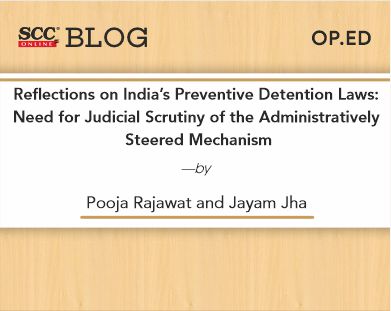Observing the blatant misuse of preventive detention laws, the Madras High Court in Manokaran v. State of T.N.1, directed the State to pay a compensation of Rupees five lakhs each to two women who were kept under illegal detention for more than four months.
The application of preventive detention, mentioned under Article 22(3) of the Constitution2 comes at the cost of undermining life and liberty. In Hem Lall Bhandari v. State of Sikkim3, the Court opined that the executive authority must ensure strict compliance and expeditious action in cases involving life and liberty. Moreover, detaining an individual merely on the apprehension amounts to subjecting the individual to punitive action without ascertaining the guilt and thus, the threshold for its applicability should be higher than other laws.
As per the data released by National Crime Records Bureau4, the number of people who were subject to preventive detention under different laws have been steadily increasing since 2017 except for the year 2020. When entire scheme of preventive detention is looked at under the Constitution of India to cull out its scope and nature, it is found that the part pertaining to preventive detention has been so drafted that it leaves a wide and unchecked discretion in the hands of the executive. Regarding the aspect of communicating the grounds of arrest to the detainee, Article 22(5) of the Constitution mentions “as soon as may be”. The use of the word “may” create a scope for the authority, who is making a detention order to justify any undue delay under the garb of reasonableness. Furthermore, clause (6) states that if the detaining authority believes that it will be “against the public interest to disclose” the grounds for the arrest to the detainee, then the authority is not under any obligation to disclose the grounds of the detention.
Though, a bare reading of this constitutional provision seems to provide wide discretion to the executive, it was added as a proviso to clauses (1) and (2) of Article 22, which means that it was intended to be used as an exception to the general rule. In Shakoor Ahmed v. State of J&K5, the Court held that Article 22(3)(b), providing for preventive detention should be understood just as an exception to the ordinary rule of protecting the life and liberty of an individual under Article 216 and hence, the recourse to preventive detention should not be taken to curb normal law and order situation. The Seventh Schedule to the Constitution7 provides for subjects pertaining to which preventive detention laws can be made, including matters like “defence, foreign affairs and security of India, the maintenance of public order, or the maintenance of supplies and services essential to the community”. This reflects the intention of the Constitution-makers to make sure that the provision of detention should not be generally applied to deal with routine matters of law and order but in cases of grave matters of public disorder. In Banka Sneha Sheela v. State of Telangana8, distinguishing between “public order” and “law and order”, the Court held that in order to establish the scenario of public disorder, the entire community or the public at large must be affected and the mere “contravention of law” is not sufficient.
Although, the Seventh Schedule mentions the grounds on which laws pertaining to preventive detention can be made, there is an absence of objective criteria to determine the applicability of the same. One such ground can be the years of imprisonment provided for such offences or by categorically listing the offences in which preventive detention can be applied. There is also a need for a provision under which, the detaining authority must report about the detention to the Judicial Magistrate under whose jurisdiction the matter may come and must submit a written report about the grounds of apprehensions behind the preventive detention. At the same time, the Judicial Magistrate should also be made obliged to ensure that the detainee has been given the access to legal representation.
In furtherance of Section 36 of the Code of Criminal Procedure, 19739, a Special Court can be constituted in order to ensure expeditious disposal of matters pertaining to preventive detention. In order to verify the justification given by the detaining authority, the Constitution (44th Amendment) Act, 197810 provided for the constitution of an Advisory Board. However, the notification to make it effective has not been issued till date. India's preventive detention laws are highly administratively steered and immediate reforms, both in the form legislative and judicial actions are required to prevent its misuse.
† Third year student, BA LLB (Hons.), National Law University, Jodhpur.
†† Third year student, BA LLB (Hons.), National Law University, Jodhpur. Author can be reached at <jayam.jha@nlujodhpur.ac.in>.
2. Constitution of India, Art. 22(3).
4. National Crime Records Bureau, Crime in India-2021, Vol. 3, p. 1276.
6. Constitution of India, Art. 21.
7. Constitution of India, Seventh Schedule.







